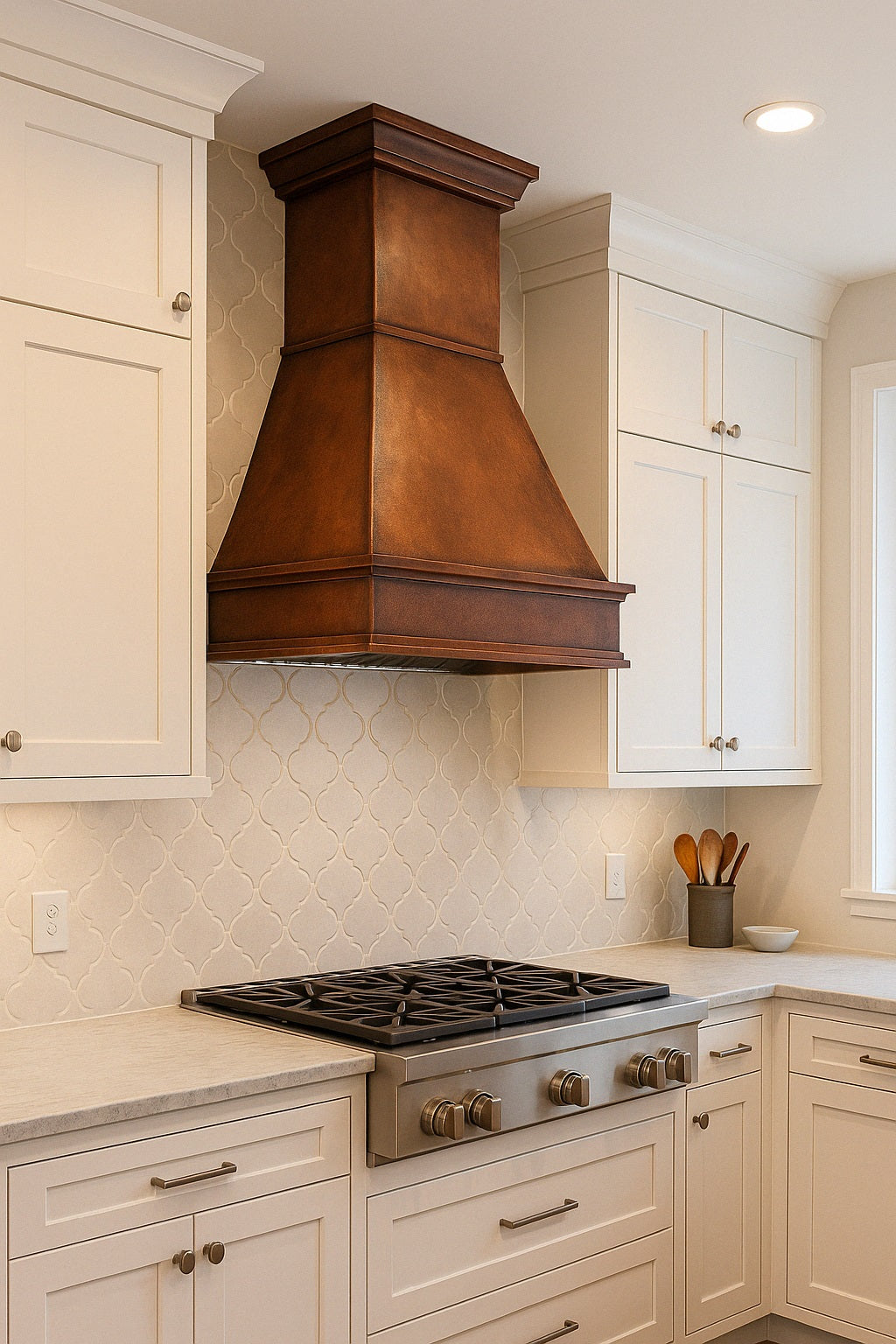
Guide to Trapezoid Copper Range Hood with Mid-Band Molding
Share
Choosing the right range hood isn’t just about airflow—it’s about marrying function and design. For a kitchen that demands architectural elegance, the trapezoid copper range hood with mid-band molding delivers both form and substance. This guide will walk you through the design, material, installation, care, and stylistic decisions you should make when investing in this statement hood.

Guide to Trapezoid Copper Range Hood
Material & Finish
This hood is crafted from solid copper, giving you the benefits of warmth, durability, and patina development. The finish is smooth—not heavily hammered—so the copper’s tonal shifts can take center stage. The warm brown patina offers soft contrast with cabinetry, tile, or stone. Over the years, this patina deepens, reflecting the history of your space. Because the surface is smooth, cleaning is simpler. The mid-band molding accentuates structure without distracting from the copper’s evolving character.
Shape & Structure
The trapezoidal bell form flares outward toward the base, drawing in rising steam while presenting a confident silhouette. The chimney is straight, framed with a mid-band molding that divides vertical space and strengthens the visual line. At the top, a strong crown molding completes the gesture; below, a wide apron band anchors the hood. That layering—the mid-band, crown, apron—gives this hood architectural proportion rarely seen in custom copper designs. The geometry feels grounded and intentional.
Design Role
In rustic or Mediterranean interiors, this hood feels at home among terra cotta, plastered walls, and exposed beams. In transitional or modern designs, it injects warmth and texture while its clean lines keep it from reading overly ornate. The structured mid-band gives it a formal rhythm that works especially well when paired with rectangular tile patterns or linear cabinetry. When well lit, the hood’s planes and edges dance with soft shadows, giving depth without relying on ornamentation.
Performance Fit
A hood must breathe well, and this one is designed around performance. Because it’s custom, the shell can match your choice of liner, from modest CFM blowers to stronger systems for heavy cooking. Whether venting to the exterior or recirculating, the hood’s geometry guides airflow efficiently. The wide apron and flared base help trap grease and steam before they escape. You want duct runs that are as straight as possible, with minimal bends, so the blower doesn’t fight resistance. Matching blower and duct size is critical.
Styling Tips
Let the hood lead the palette. Warm metals, soft neutrals, and natural surfaces like stone, plaster, and wood complement the copper best. Tile backsplashes with rectangular or linear layouts echo its geometry. Iron lighting and hardware unify with copper accents. For modern spaces, pair it with flat-panel cabinetry and clean countertops, letting the hood be the sole flourish. In more traditional settings, the molding echoes brackets, corbels, or crown detail elsewhere, creating cohesion. Soft lighting helps the copper glow, especially in the evening.
Installation Advice
Because copper is denser than many metals, reinforce wall or ceiling supports beforehand. Mount the hood 28 to 36 inches above the cooktop to balance capture and visual proportion. Size the chimney height to match ceiling or soffit heights. Keep duct runs efficient—short and straight is better. Confirm that your blower and liner choices will align neatly with the shell. Hide seams or transitions behind cabinetry or ceiling elements so the hood reads as a cohesive piece, not a retrofit.
Care & Aging
Maintenance is low with this smooth copper hood. Use a soft cloth and gentle soap to wipe occasional grease. Avoid abrasives or harsh cleaners that strip patina. If you prefer to slow change, a waxing coat helps—but many owners let the copper evolve naturally. Over time, the patina deepens and highlights edges. Minor marks often blend in, reinforcing the hood’s story. The clean surface means no hidden crevices that collect grime. This hood becomes a dialogue between material and time.
Key Considerations
• Solid copper shell, smooth patina • Trapezoid bell form with mid-band molding • Crown and apron layering • Custom fit for your blower • Compatible with ducted or recirc • Architectural presence and warmth
Summary Thoughts
When purchasing a range hood, it’s easy to focus only on performance. But with the trapezoid copper hood with mid-band molding, you get both. It is designed to breathe, but also to elevate. Its structured geometry, clean surface, and evolving patina make it a lasting presence in your kitchen. Choose dimensions and finishes carefully, match liner and ducting, and install with precision—and your hood becomes more than a utility: it becomes architecture. This is your guide to making that choice with confidence.
